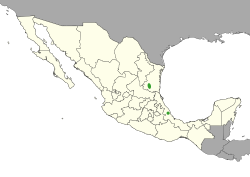Biology:Cephalocereus euphorbioides
| Cephalocereus euphorbioides | |
|---|---|

| |
| Scientific classification | |
| Kingdom: | Plantae |
| Clade: | Tracheophytes |
| Clade: | Angiosperms |
| Clade: | Eudicots |
| Order: | Caryophyllales |
| Family: | Cactaceae |
| Subfamily: | Cactoideae |
| Genus: | Cephalocereus |
| Species: | C. euphorbioides
|
| Binomial name | |
| Cephalocereus euphorbioides (Haw.) Britton & Rose
| |

| |
| Synonyms | |
| |
Cephalocereus euphorbioides is a species of Cephalocereus from Mexico.
Description
Cephalocereus euphorbioides grows with rarely branching green shoots 3 to 5 meters tall and 10 to 11 centimeters in diameter. The 8 to 10 noticeable ribs are clearly wavy. The thorns are only upright in the flower zone and are otherwise more or less horizontal. The single, strong central spine is dark brown and up to 3 centimeters long. The 7 to 9 straight, light gray marginal spines have a darker tip and are 5 to 12 millimeters long.
The narrow, bell-shaped flowers usually appear in large numbers near the tips of the shoots. They are reddish pink, 5 to 8 centimeters long and reach 7 centimeters in diameter. Its pericarpel and floral tube are covered with small tubercles with nectar glands and small scales. The green fruits are up to 8 centimeters long.[2]
Distribution
Cephalocereus euphorbioides is distributed in the Mexican states of Tamaulipas, San Luis Potosí and Veracruz.
Taxonomy
The first description as Cereus euphorbioides was in 1819 by Adrian Hardy Haworth.[3] The specific epithet euphorbioides is derived from the Greek word -oides for 'similar' and the genus 'Euphorbia'. Nathaniel Lord Britton and Joseph Nelson Rose placed the species in the genus Cephalocereus in 1920. Further nomenclature synonyms are Cactus euphorbioides (Haw.) Spreng. (1825), Pilocereus euphorbioides (Haw.) Rümpler (1886), Lemaireocereus euphorbioides (Haw.) Werderm. (1934), Carnegiea euphorbioides (Haw.) Backeb. (1944), Neobuxbaumia euphorbioides (Haw.) Buxb. (1954), Neodawsonia euphorbioides (Haw.) Buxb. (1957) and Rooksbya euphorbioides (Haw.) Backeb. (1960).[4]
References
- ↑ Biología, Héctor Hernández (Instituto de; Group), Succulent Plants Specialist (2009-04-28). "The IUCN Red List of Threatened Species". IUCN Red List of Threatened Species. https://www.iucnredlist.org/species/151979/121516667. Retrieved 2023-10-30.
- ↑ Anderson, Edward F.; Eggli, Urs (2005) (in de). Das grosse Kakteen-Lexikon. Stuttgart (Hohenheim): Ulmer. p. 438. ISBN 3-8001-4573-1.
- ↑ Haworth, A.H. (1819) (in la). Supplementum Plantarum Succulentarum: Sistens Plantas Novas Vel Nuper Introductas, Sive Omissas, in Synopse Plantarum Succulentarum, Cum Observationibus Variis Anglicania. Impensis J. Harding. p. 75. https://books.google.com/books?id=Ww8AAAAAQAAJ&pg=PA75. Retrieved 2023-10-30.
- ↑ Britton, Nathaniel Lord; Eaton, Mary E.; Rose, J. N.; Wood, Helen Adelaide (1919). The Cactaceae : descriptions and illustrations of plants of the cactus family. Washington: Carnegie Institution of Washington. doi:10.5962/bhl.title.46288.
External links
Wikidata ☰ Q41793237 entry
 |





